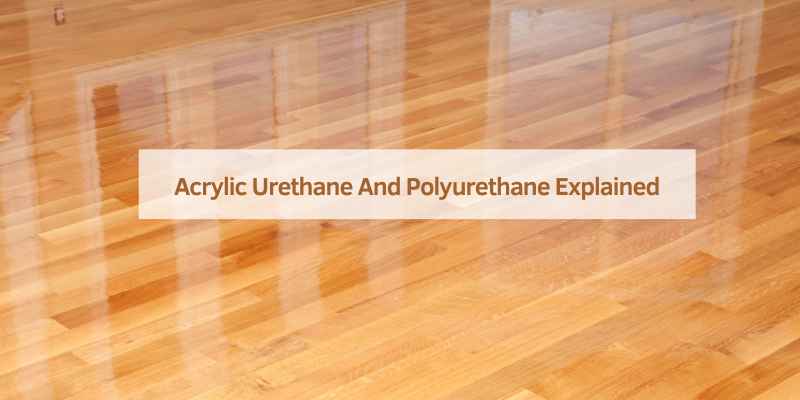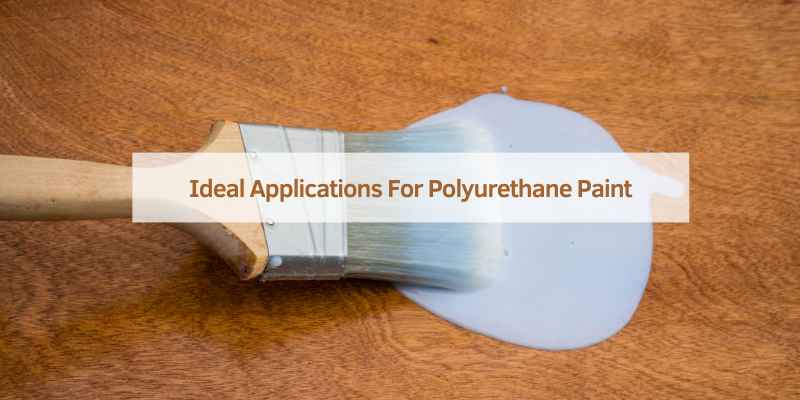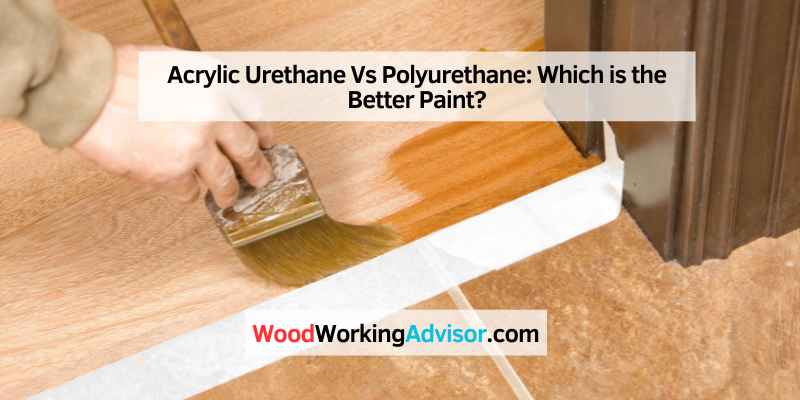Polyurethane is a synthetic resin created by combining an isocyanate and alcohol that provides better durability, heat resistance, and chemical stability than acrylic urethane due to its complex chemical properties. Acrylic urethane, on the other hand, is a great option that lasts as long as enamel paint and is easy to apply but requires a catalyst during mixing.
Acrylic urethane and polyurethane are two types of coatings used in industries such as automotive, furniture, and construction. While they share similarities in terms of providing a clear and shiny finish and protecting surfaces from wear and tear, they differ in their chemical composition and application methods.
We’ll explore the differences between acrylic urethane and polyurethane, their advantages and disadvantages, and which one to choose for your project.
Acrylic Urethane And Polyurethane Explained
Acrylic urethane and polyurethane are two different synthetic resins with varying properties. While urethane is more chemically complex, has better durability, heat resistance, and chemical stability, its quality can vary across brands and tends to yellow in ultraviolet light, whereas acrylic urethane is easier to apply and does not yellow.
Both types of paints are available in various colors and finishes.
What Is Acrylic Urethane Paint?
Acrylic urethane paint is a coating that uses acrylic and urethane resin as a medium. This type of paint dries quickly, is highly durable, and resistant to chemicals and weathering. Acrylic urethane is a popular choice for car paint jobs and can provide a glossy, high-quality finish to any surface. It is preferred over traditional paints because it is easy to apply, has low VOC emissions, and requires no mixing of solvents.
What Is Polyurethane Paint?
Polyurethane paint is another type of coating that is created by combining isocyanate and alcohol. This paint dries slower than acrylic urethane and is harder and more brittle. Polyurethane is popular in industries that require high durability, heat resistance, and chemical stability. It is typically used on surfaces like floors, machinery, and pipes. Polyurethane comes in both one-component and two-component forms.
Comparison Of Acrylic Urethane And Polyurethane
| Property | Acrylic Urethane | Polyurethane |
|---|---|---|
| Drying Time | Quick | Slow |
| Durability | High | Very High |
| Chemical Resistance | High | Very High |
| Flexibility | Good | Poor |
| Application | Easy | Difficult |
| Cost | Lower | Higher |
In conclusion, both acrylic urethane and polyurethane have their unique benefits and drawbacks. Acrylic urethane is the preferred option for car paint jobs because of its quick-drying time, high durability, ease of application, and low VOC emissions. Meanwhile, polyurethane is used in industries that require high durability, heat resistance, and chemical stability. The choice between these two coatings depends on the specific needs of the surface being painted.

Pros And Cons Of Acrylic Urethane Paint
Acrylic Urethane paint has several pros and cons when compared to polyurethane. Acrylic Urethane is easy to apply and lasts as long as enamel paint, however, it requires a catalyst during the mixing and thus must be applied quickly. Polyurethane, on the other hand, is preferred when industries require durability, heat resistance, and chemical stability.
When it comes to choosing the right paint for your project, one of the most important decisions you’ll make is whether to use acrylic urethane or polyurethane paint. Each has its own unique set of properties, pros, and cons. In this article, we’ll dive into the pros and cons of acrylic urethane paint.
Advantages Of Using Acrylic Urethane Paint
Acrylic urethane paint is a popular choice for those who want a durable, long-lasting finish. Here are some advantages of using acrylic urethane paint:
- Durability: Acrylic urethane paint is known for its durability and resistance to chipping, fading, and peeling.
- Chemical Resistance: It is also resistant to chemicals, making it a great choice for paint jobs in industrial settings or areas with exposure to harsh chemicals.
- UV Resistance: Acrylic urethane paint is also resistant to UV rays, which means that it will maintain its color for a longer time, even when exposed to the sun.
- Fast Drying Time: The fast-drying time of acrylic urethane paint makes it a great choice for jobs that require multiple layers of paint.
- Easy to Apply: Acrylic urethane paint is easy to apply with a brush, roller or spray gun.
Disadvantages Of Using Acrylic Urethane Paint
While there are many advantages of using acrylic urethane paint, there are also some disadvantages. Here are some of the cons:
- Cost: Acrylic urethane paint is more expensive than other types of paint, making it less accessible for those on a tight budget.
- Preparation: Before applying acrylic urethane paint, you may need to do significant preparation of the surface such as sanding and priming specifically when it is applied to wood surfaces.
- Application Time: The fast-drying time of acrylic urethane paint may also be a disadvantage for some. The quick-drying can cause problems, especially when working in hot climates or during application through spray guns which not only dries the coating but also cause overspray.
In conclusion, acrylic urethane paint is a great choice for anyone looking for a durable, long-lasting finish that is resistant to chemicals and UV rays. However, it may not be the best choice for those on a tight budget or looking for a fast-drying paint that requires little preparation. Ultimately, it’s important to consider all the pros and cons before making your decision and choose what works best for your specific project.
Pros And Cons Of Polyurethane Paint
Polyurethane paint has several pros and cons when compared to acrylic urethane paint. Polyurethane is known for its durability, heat resistance, and chemical stability, making it a popular choice in industries that require these qualities. However, polyurethane paint tends to yellow in ultraviolet light and can be more difficult to apply than acrylic urethane paint.
On the other hand, acrylic urethane paint is easy to apply and has good resistance to water, oils, household cleaners, and abrasion, but its quality may be less consistent across brands.
Polyurethane paint is a type of synthetic resin that is made by combining isocyanate and alcohol. The resulting product is a high-quality paint that offers numerous benefits over other types of paint. In this section, we will discuss the advantages and disadvantages of using polyurethane paint.
Advantages of Using Polyurethane Paint
There are many advantages of using polyurethane paint, including:
– Durability: Polyurethane paint is extremely durable and resistant to wear and tear. It is ideal for use in high-traffic areas and can stand up to heavy use without chipping or fading.
– Chemical Resistance: Polyurethane paint is resistant to a wide range of chemicals, and can therefore be used in industrial settings where exposure to chemicals is common.
– Moisture Resistance: Polyurethane paint is also resistant to moisture, making it an excellent choice for use in areas that are frequently exposed to water or humidity.
– Versatility: Polyurethane paint can be used on a variety of surfaces, including metal, wood, and concrete. It is also available in a range of colors and finishes to suit any application.
Disadvantages of Using Polyurethane Paint
While there are many advantages to using polyurethane paint, there are also some potential drawbacks to consider. These include:
– Cost: Polyurethane paint is typically more expensive than other types of paint, due to its high quality and durability.
– Application Complexity: Application of polyurethane paint can be more complex than other types of paint, as it requires mixing of multiple components and the use of a respirator due to fumes.
– Long Drying Time: Polyurethane paint can take longer to dry than other types of paint, which can be a disadvantage if the surface needs to be used quickly.
In conclusion, polyurethane paint offers numerous advantages over other types of paint, including excellent durability, chemical and moisture resistance and versatility. However, it can be more expensive, complex to apply, and has a longer drying time than other types of paint. Ultimately, it’s important to weigh these pros and cons when deciding if polyurethane paint is the right choice for your project.
Comparing Acrylic Urethane And Polyurethane Paints
Acrylic urethane and polyurethane paints have different properties due to their chemical differences. Polyurethane is preferred for its durability, heat resistance, and chemical stability, while acrylic urethane is a great option that is easy to apply and requires a catalyst.
The main difference between them is that acrylic paint is water-based while polyurethane paint is usually oil-based.
The choice between acrylic urethane and polyurethane paints largely depends on the project’s requirements and the user’s experience. When comparing acrylic urethane and polyurethane paints, several factors come into play, including ease of use, durability, application, color retention, and chemical resistance.
Ease Of Use
Both acrylic urethane and polyurethane paints require similar preparation processes, but acrylic urethane paint is generally easier to use. Acrylic urethane requires less time to dry, and beginners can apply it with ease as it doesn’t require a catalyst, unlike polyurethane.
Durability
When it comes to durability, polyurethane outshines acrylic urethane paint. Polyurethane is widely used for high-durability applications, including aerospace, marine, and automotive industries. Unlike acrylic urethane paint, polyurethane can withstand extreme weather, chemicals, abrasions, and impacts.
Application
Acrylic urethane paint can be applied to a variety of surfaces, including wood, fiberglass, and plastic. It’s an ideal option for DIYers, as it can be applied using a brush, roller, or sprayer. On the other hand, polyurethane is thicker and may require a professional to apply to ensure a seamless finish.
Color Retention
Both acrylic urethane and polyurethane paints offer excellent color retention, meaning they won’t fade easily, even when exposed to sunlight. However, polyurethane is more resistant to color fading over time.
Chemical Resistance
Polyurethane offers better chemical resistance than acrylic urethane paint. Polyurethane can withstand exposure to harsh chemicals without getting damaged, while acrylic urethane paint may have chemical reactions if exposed to certain chemicals.
In conclusion, both acrylic urethane and polyurethane paints have their uses. Acrylic urethane is best for DIYers and projects needing a quick turnaround, while polyurethane is preferred for high-durability applications. Consider the factors of ease of use, durability, application, color retention, and chemical resistance to determine which paint is best for your project.
Ideal Applications For Acrylic Urethane Paint
Acrylic urethane is a great option for applications where a durable and chemically stable finish is needed. Unlike polyurethane, which tends to yellow in ultraviolet light, acrylic urethane paint is more consistent in quality across brands. Whether you need to paint a car or protect wooden surfaces, acrylic urethane can deliver a crystal-clear and long-lasting finish.
Acrylic urethane paint is a popular choice for various industries due to its durability, resistance to weather, and vibrant color options. The paint is water-based, making it easier to use and clean, and it provides a good finish with a long lifespan. Let’s review the ideal applications for acrylic urethane paint in the automotive industry, furniture industry, and construction industry.
Automotive Industry
When it comes to the automotive industry, acrylic urethane paint is an excellent choice for painting cars, trucks, and motorcycles. The paint provides a high-quality finish that resists chipping, peeling, and fading. It also protects the vehicle from ultraviolet rays, moisture, and rust. With acrylic urethane paint, the vehicle’s exterior can maintain its original look for years.
Furniture Industry
Acrylic urethane paint is also great for furniture painting. Its fast-drying capabilities and versatility make it an excellent choice for painting various furniture pieces. You can use acrylic urethane paint to paint wooden chairs, tables, shelves, and cabinets, providing them with a protective layer that lasts for years. Additionally, by using different types of brushes and techniques, you can create various finishes with acrylic urethane paint.
Construction Industry
When it comes to the construction industry, acrylic urethane paint is a popular choice for painting exterior and interior surfaces. The paint is great for wood, concrete, and metal surfaces. With its high durability and ability to resist excessive weather exposure, acrylic urethane paint can provide long-lasting protection to outdoor structures such as garages, fences, and decks. While for interior surfaces, acrylic urethane paint’s water-based properties make it ideal for painting walls, ceilings, and floors.
Conclusion
Acrylic urethane paint is a versatile option, best known for its durability, resistance to weather elements, and vibrant color options, ideal for various industries. With the swift-drying attributes and eco-friendly features, it continues to grow in popularity each day.
Ideal Applications For Polyurethane Paint
Polyurethane paint is preferred in industries that require chemical stability, heat resistance, and durability when compared to acrylic urethane. Urethane is more complex chemically, hence having different properties than acrylic urethane. It is an ideal choice for coating materials that are exposed to extreme temperatures, chemicals, or weather conditions.
Polyurethane is a synthetic resin, which is created by combining an isocyanate and an alcohol. Due to its durability, heat resistance and chemical stability, polyurethane is ideal for various industrial applications. Polyurethane paint finds its application in various industrial areas like marine and equipment industry. Polyurethane paint provides an excellent finish, high gloss, and excellent resistance to UV rays, abrasion, and corrosion. In this article, we’ll take a closer look at some of the ideal applications for polyurethane paint.
Marine Industry
The marine industry requires a coating that can withstand extreme environmental conditions. Polyurethane paint provides excellent durability, long-lasting protection, abrasion, and impact resistance. Polyurethane coatings can protect the substrate from harsh marine environments, including salt spray, water immersion, and ultraviolet light. Polyurethane coatings are commonly used in the coatings of boats, ships, and submarines. These coatings provide an excellent high gloss to the vessels, making them visually appealing.
Industrial Equipment Industry
Polyurethane coatings are ideal for the industrial equipment industry as these coatings provide excellent chemical and abrasion resistance. These coatings protect the industrial equipment from damage caused by chemicals and solvents. Industrial equipment coatings require coatings that can endure the various environmental conditions that the equipment can be exposed to. Polyurethane coatings can meet these requirements and provide superior performance. These coatings are used on industrial machinery, tools, and equipment to enhance their durability and prolong their life.
In conclusion, polyurethane paint is ideal for various applications like the marine industry and industrial equipment industry. These coatings provide outstanding protection against harsh environmental conditions, are long-lasting, and offer high gloss and color retention. Polyurethane coatings also provide protection against abrasion, impact, and corrosion. The next time you think of an industrial-grade coating system think of polyurethane paint.

Frequently Asked Questions For Acrylic Urethane Vs Polyurethane
Is Polyurethane The Same As Acrylic Urethane?
No, polyurethane is chemically more complex than acrylic urethane, so it has different properties. In industries that require durability, heat resistance, and chemical stability, polyurethane is preferred, whereas acrylic urethane is a great option for surfaces that need protection from water, oils, household cleaners, and abrasion.
Is Acrylic Urethane Good?
Yes, acrylic urethane is a good option for paint as it is durable and easy to apply. However, it requires the use of a catalyst during mixing and must be applied quickly to avoid drying up too fast. In comparison to polyurethane, acrylic urethane is less chemically complex and may vary in quality across brands.
Polyurethane is preferred for industries requiring durability, heat resistance, and chemical stability.
Can You Use Acrylic Urethane On Wood?
Yes, acrylic urethane can be used on wood. ClearGuard Waterborne Acrylic Urethane is a good option to protect wood surfaces as it has good resistance to water, oils, household cleaners, and abrasion. It brings durable protection and has a crystal-clear finish.
Acrylic paint is water-based while polyurethane paint is usually oil-based, and both are available in various colors. However, acrylic urethane typically costs more than polyurethane and has less consistent quality across different brands.
Is Acrylic Urethane Oil Or Water Based?
Acrylic urethane paint can be either oil or water-based. The main difference between acrylic paint and polyurethane paint is that acrylic paint is generally water-based while polyurethane paint is usually oil-based. However, there are a variety of both types of paints available in the market.
Conclusion
To sum it up, when it comes to choosing between acrylic urethane and polyurethane, it ultimately depends on your specific needs and preferences. Acrylic urethane is great for providing a long-lasting finish and is easy to apply, but it does require a catalyst for mixing and may be more expensive than polyurethane.
On the other hand, polyurethane offers superior durability and chemical stability, making it a preferred choice in industries that require such properties. Whatever your choice may be, make sure to consider the pros and cons of each type of paint before making a decision.


